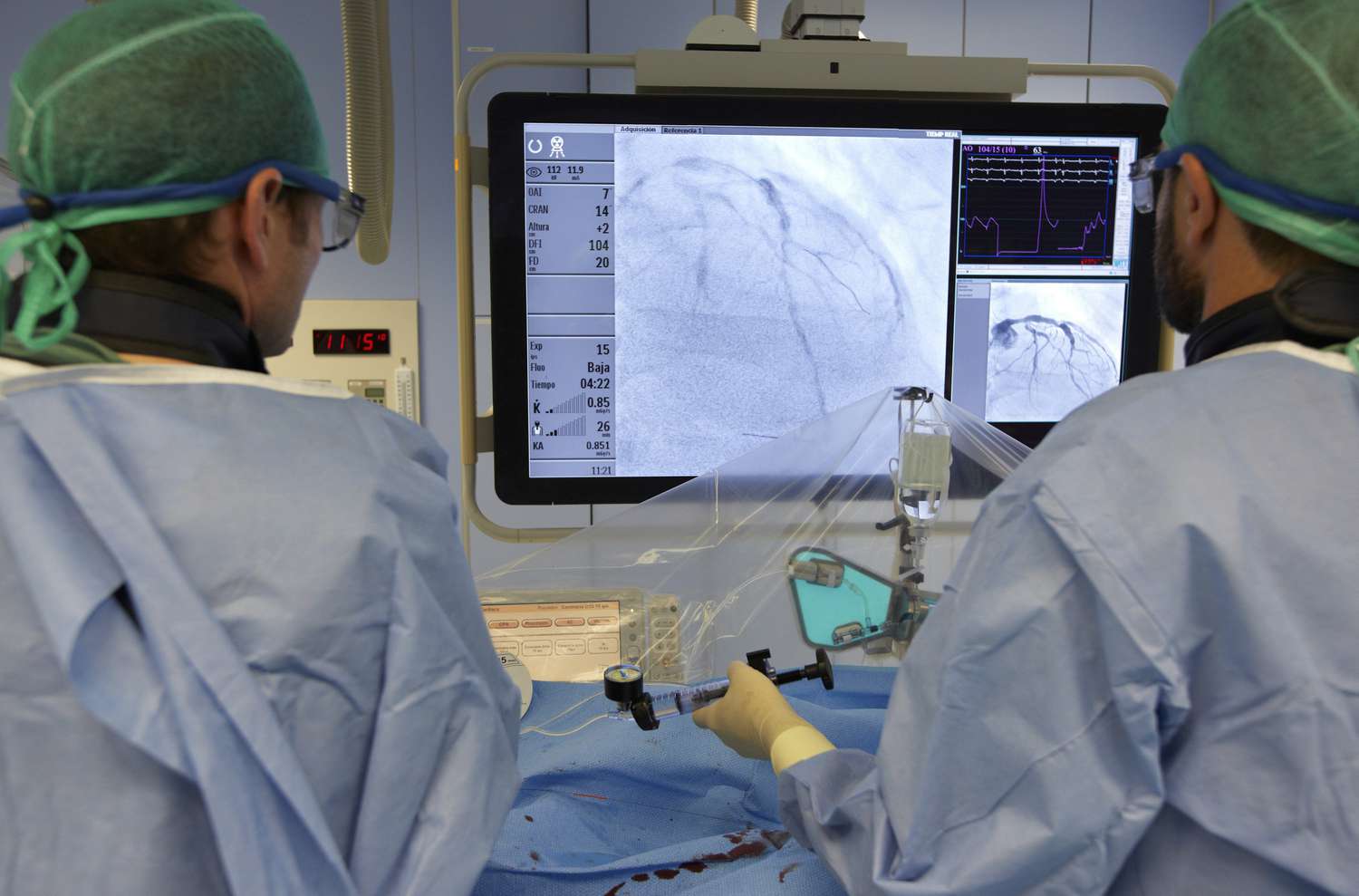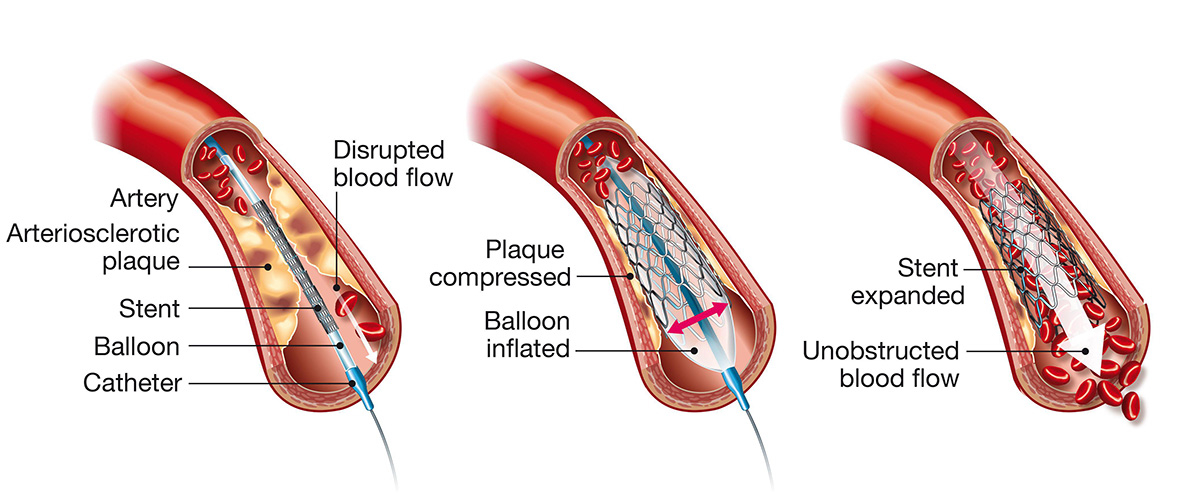
Key facts
- Angioplasty is a medical procedure used to increase the flow of blood through a narrowed artery.
- During angioplasty, a small balloon is inflated in the affected blood vessel, opening it and allowing more blood flow.
- Angioplasty may be used in many different areas of the body to restore blood flow.
- Common sites for angioplasty include the heart, brain, kidneys and legs.
- Angioplasty usually takes 30 to 60 minutes, but you many need to stay in hospital for overnight after the procedure, depending on your condition.
What is angioplasty?
Angioplasty is a medical procedure used to increase the flow of blood through a narrowed artery.
During angioplasty, a long thin tube (catheter) is inserted into a blood vessel to place a small balloon at the site of the narrowing. The balloon is inflated, causing the blood vessel to open, and allow a healthy flow of blood. If your doctor is concerned that the artery will not stay open by itself, they may insert a stent. This is a small metal tube, which is left inside the artery to help keep it open.
The procedure is done at the same time as an angiogram. This is a special kind of x-ray image that shows the arteries live on a screen. Doing angioplasty together with an angiogram allows the doctor to see exactly what is happening to your arteries in real-time and perform the procedure safely.
Why might I need angioplasty?
Your doctor may recommend angioplasty if you have a narrowed artery that reduces the amount of blood reaching a part of your body. Reduced blood supply means that less oxygen reaches the area, which can put you at risk of tissue damage.
Angioplasty is commonly used on the arteries that supply blood to heart muscle (coronary arteries). Coronary angioplasty can help relieve the symptoms of angina (chest pain). It can also be used to restore blood flow to the affected area in your heart after a heart attack.
Different procedures are used for different conditions. Here are some common procedures:
- Percutaneous coronary intervention (PCI, also called percutaneous transluminal coronary angioplasty, coronary angioplasty or balloon angioplasty) is used to open clogged heart arteries.
- Cerebral angioplasty is used to open blood vessels in the head and neck to prevent a stroke.
- Angioplasty of the leg is used to restore blood flow to the leg, prevent pain or avoid later amputation.
- Renal artery angioplasty is used to reduce high blood pressure caused by problems with your kidney’s blood vessels.
How do I prepare for an angioplasty?
Your preparation will depend on your medical condition at the time of the procedure, and any medicines you are taking.
Your doctor might ask you to stop taking certain medicines that can thin the blood and cause bleeding. You will probably have to fast for several hours before the procedure.
Make sure you tell your doctor if you have any history of kidney disease, abnormal kidney function or diabetes. This is because the dye used during angiography is processed by the kidneys. If you have kidney problems, you may need to take extra precautions before the procedure, which your doctor will discuss with you.
What happens during an angioplasty?
- You will usually be given a sedative to help you relax and then you’ll have an injection of local anaesthetic in the skin near an artery, usually in the groin, to numb the area.
- A guide wire is inserted with a needle into the artery and then a sheath is passed over the wire into the artery. The sheath is a plastic tube.
- A special dye is then injected into the artery so that it shows up on the x-ray (an angiogram). The angiogram will help your doctor choose the correct-sized balloon.
- A very thin tube (catheter) with the balloon on the end is then passed through the sheath.
- When it reaches the narrowing, the balloon is inflated to stretch the artery and then the wire and balloon are removed.
- Often this is enough to open the artery. In some cases, a small wire mesh tube (called a stent) is placed in the artery to help keep it open after the procedure.
- Finally, the sheath is removed, and pressure, or a device, is used to close the artery and stop any bleeding.
Angioplasty usually takes 30 to 60 minutes.
Coronary angioplasty is usually performed by a specially trained cardiologist. Other angioplasty procedures are usually performed by an interventional radiologist.

A stent, a wire mesh tube, is inserted into the artery to keep it open.
What should I expect after an angioplasty?
You will need to lie flat for 1 to 4 hours and probably stay in hospital overnight, or for longer if angioplasty was done as an emergency procedure.
You might have pain or bruising where the wire was inserted, or discomfort at the site of a stent. Most people can do moderate intensity activities the day after the procedure.
What are the complications of angioplasty?
Angioplasty is generally regarded as safe.
Some people have allergic reactions to the dye used in the x-ray procedure or other medications. The doctors performing the procedure are equipped to handle this, if it happens.
On rare occasions, blood vessels or nerves are accidentally damaged during the procedure, which can cause long-term problems.
If you have severe pain or bleeding after angioplasty, you should see a doctor without delay.

